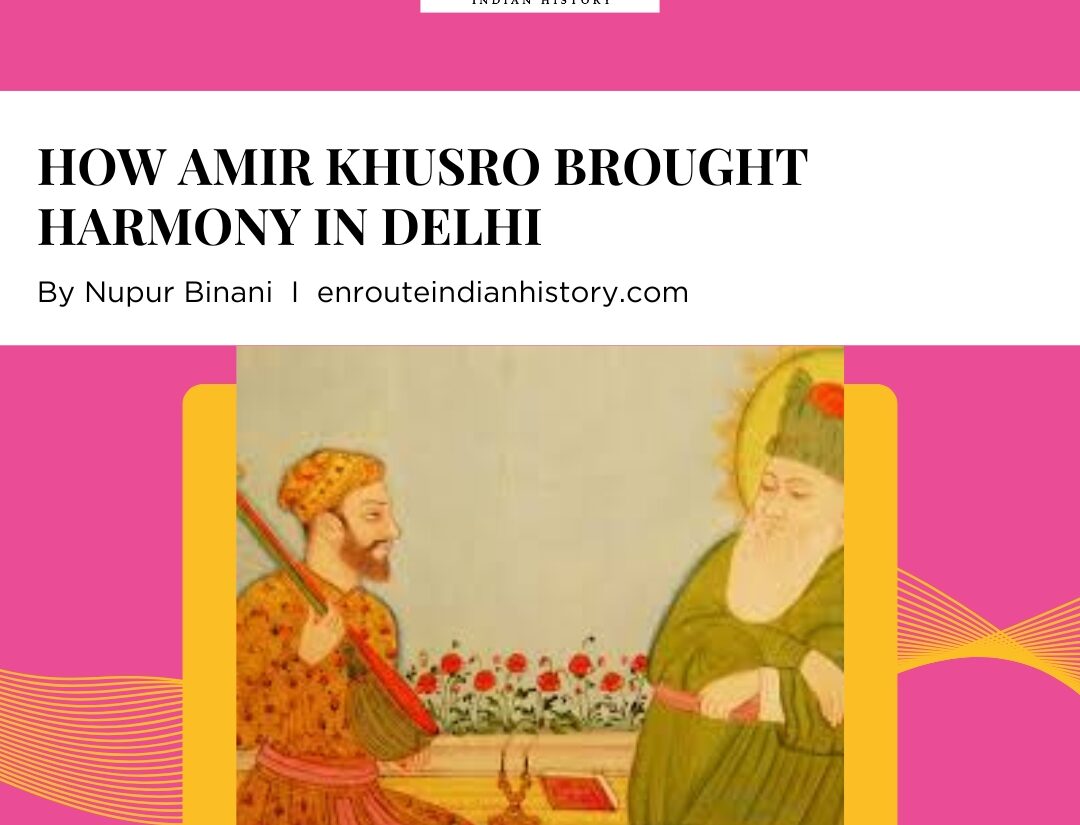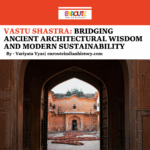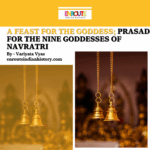
Amir Khusrau
The Indian Subcontinent witnessed most long surviving civilizations, kingdoms and cultures. India being the most suitable country for major aspects attracted attackers to keep an eye on, beginning medieval India with numbers of raids and attacks. The first Muslim raids in the subcontinent were made by Arabs on the western coast and in Sindh during the 7th and 8th centuries. This road of conquest was achieved after more than 20 attacks by Mahmud of Ghazni between 1001- 1027 leading to the establishment of Delhi Sultanate. The Sultanate was not just a political fragment in the pages of history while its multicultural dimension shaped the social formations. The period is signified by synthesis of Persian, Central Asian and Indian elements, Art and architecture, Governance, Trade and Urbanisation, Caste and religion known by its rich literature. The charm of the period was the presence of Poets, Scholars, sufi saints, artisans and craftsmen whose literary works act as one of the greatest sources to reconstruct history. This gave birth to the known parrot of India- Amir Khusrau.

(A world heritage of native.www)
Ab’ul Hasan Yamīn ud-Dīn Khusrau, famously known as Amir Khusrau was born in 1252 in Patiyali, near Badaun in western Uttar Pradesh. From his childhood, he saw a mix of turk and rajput culture for which he mentioned “I am a Turk of Hindustan, I answer in Hindavi. I don’t have Egyptian sugar to speak Arabic”. Khusrau’s love and admiration for his motherland is transparent through his work, his patriotism made him described as Tooti- e- hind (The singing bird of India). In 1310 Khusrau became a disciple of a famous Sufi saint of the Chishti Order, Nizamuddin Auliya. At the feet of his mentor, Khusrau sang the song of love to masses who enjoyed his folk song and literature. His Persian poetry became famous and is still sung by qawwals in Nizamuddin Dargah, Delhi.
The period which is facilitated by a rigid style of writing, Amir Khusrau had different plans. He was a multifaceted, multi-talented poet termed as Renaissance man who wrote about political, social and cultural aspects of Indian life. His writings are valuable not only as literary sources but also for historical, social and political insight. Indeed, a true man for cultural synthesis between Hindu and Muslim civilization.
Prof. K.M. Ashraf states “the teaching of Quran appears to have worked more or less satisfactorily in the tribal surroundings and the strong democratic traditions of Madina. But as soon as Islam began to expand beyond the limits of a city state, the inspired word of God, failed to be elaborated for the working of a more extensive political structure …”The Muslim world had regeneration as it started expanding itself to the world. The Turks brought their own heritage in Indian civilization which was far different from Arabian culture. While scholars opined Sanskrit lost its value in Delhi Sultanate and Mughal period but we see composite perception by Amir Khusrau towards Non Muslims. Through his text, we find usage of different languages varied from region to region from Sindhi, Lahauri, Kashmiri, Kubri, Dhur-Samandri, Tilangi(Telugu), Gujar(Gujarati), Gauri(North Bengal), Bengali, Awad to Delhi.

(InquiriesJournal.www)
One of his poems describes his respect towards the pluralistic nature of Indian culture.
“The people of Khita, Mongol, Turks and Arabs In speaking Indian dialects get sewn lips But we can speak any language of the world As expertly as a shepherd tends his sheep .” This is a tributary couplet written in Indo Western Bhojpuri language and a romantic description of his beloved master Sheikh Nizamuddin Auliya. “Tarah tarah kay phool lagaaye, lay gadhwa haathan mein aaye. Nijamudin kay darwazay par…”. There are numerous examples scattered in his compositions which ascertained the diverse familiarity and the dealings of Khusrau with these linguistic genres.
The words used in his poems show an attempt to understand different religions and cultures. The word Rang or Rung is generally used as color in Hindi and most of the north Indian language and is not a Persian or Urdu term which is often mentioned in his poems. Words like “Mahbūb-e-ilāhī‟ are a combination of Urdu and Arabic, later they were famously used in Nizamuddin Dargah.
The period where other writers focused on criticizing Non muslims elements, Amir Khusrau attempted to understand the multidimensional form of Indian society, remarking as a Renaissance man. He didn’t exclude a single theme of Hindu society while understanding in- depth philosophical chapters of human life and existence.
“Hind was a paradise for the unbelievers from the advent of Adam till the coming of Islam. Even in recent times, these infidels have had every pleasure of heaven like wine and honey ”, he justified love, respect and superiority of motherland by usage of Hub al watan min al-iman” (the love of motherland is an essential part of the true faith).
The portrayal of Amir Khusrau in this way should not be ignored by the fact that he did not have a soft corner of alienated non – Muslim, few of his poems give us the other side of the coin. Few mentioned poems familiarize us with the other side,
“I grew pale before the Hindu idol. Alas, he had no idea of my distress. I told him,I want to kiss your lips.‟ He laughed and said, Nahi Nahi‟, a proscriptive no.
“One day I was strolling by a stream When I saw Hindu lass on the bank I asked,my pretty, how much for your hair?‟ She cried,”A pearl for every strand,‟ Or Get Lost, you wretch‟ in the Hindavi sense.”
Though, he gave privilege to Sanskrit but was psychologically motivated towards Arabic as it was considered superior to Sanskrit and Persian was quite ignorant. His respect for Brahman is reflected by his statements conveying Brahman to be intellect and far superior to the knowledge of all the books of Aristotle.

(Scroll.in)
Reconstructing history from the point of view of gender relations, we need to uncover evidence of social processes; the factor ignored due to prevailing biases towards women. Amir Khusrau relooked women’s position in social background .We find inadvertent references of women in his versatile writing in the form of diwans, Khamsa, Rasail, amongst Mathnavis Miftah al-Futuh and Nuh Sipihr. K.M. Ashraf comments on him as a ‘pre-imminently a historian of contemporary social life’, who writes
on social behavior, family life, virtues and vices of society. Amir Khusrau too writes at length about women but within a religious and socio-cultural context. Therefore, Khusrau’s representation of women is often crafted through the renunciation of dominant forms of femininity as connoting domesticated female persona.
The basic idea is formed by long sermons written in Hasht Bahisht and Matla-ul Anwar, these would lead one to think that the great poet was extremely orthodox and conservative in his attitude towards women as in one of the verse he mentioned he seems to lament the birth of his daughter but then immediately retracts and offers his thanksgivings to God for the gift and with full realization says that his father had also a mother and there was no case of any one being born without a mother. In Hasht Bahisht while addressing Mastura, his seven years old daughter, he wished that if she was born in the eighth month she would not have survived but again immediately withdraws and accepts that as what God has given has to be justified right and proper. He emphasized on the idea of privacy and seclusion, in a metaphoric expression he compared a free woman with a bitch. He stresses on the conventional dress code in which the importance of dupatta, considering an unveiled face just like an uncovered food open for cats and dogs to smear. It seems that Amir Khusrau belongs to a static almost ossified state of society wherein the different sorts and conditions of men perform traditional functions in obedience to traditional norms of conduct. His empathic nature towards women terms wine to be the root cause of family destruction hence very critical of a woman drinking wine, as a sign of destruction.

(scrolldroll.com)
Ironically, many of his ghazals were recited by dancing girls. Ijaz-i Khusravi describes the indecency of a dancing girl who in between her performance attended the call of nature in front of all present. Nuh Sipihr tells us of the Indian dancing girls with their forehead decorated with sandals and jewels, the parting of their hair being filled with pearls and diamond pendants, wearing a nose ornament and clad in the Devagiri garment. Dancers and singers were considered a distraction for the youth, the sultan was not in favor of prostitution still fixed their rates. One mention is in Risala, of Didi Miskin of Devagiri who made her black face white to cast glamorous side glances on people.
Khusrau is the first to raise an issue on Adultery, he writes contemptuously on Zani (adulterer considered sinner) how Ala-ud-din Khalji introduced harsh punishment of castration for the adulterer and death for adulterers.The existence of sects like Mulahidan and Ibahatiyan during the Sultanate period spoke volumes of the immorality that had crept into the society.
أنت طفلي الصغير الآن ولكنك ستكبر يومًا ما، هذا تقليد
كبار السن أن يقدموا بعض النصائح لصغارهم. لذلك، أريد أن أعطيك بعض
نصيحة. كعروس، فإن مسؤوليتك الأولى هي الحفاظ على تواضعك. ال
يجب أن يقتصر نشاط المرأة على المنزل فقط. لا ينبغي لهم أن زقزقة
حول؛ إن التجول بلا هدف أمر مخز بالنسبة للنساء
الذين يتجولون ليسوا نساء بل عاهرات.
You are my little child now but one day you will be grown up, it is a tradition of elders that they give some advice to their young ones. So, I want to give you some advice. As a bride it is your first responsibility to safeguard your modesty. The activities of women should be confined to the house only. They should not peep around; aimless wandering is shameful for women. The ones who roam about are not women but bitches.

(Dillikidiva.com)
Though, he is taken to be conservative and brings about the inherent prejudice against women. His writings project him not only as an orthodox person but one with puritanical ideas of being either black or white. It reflects the ignored, suppressed and in depth suffering of women of Medieval India. His views raised feminist historiography as being rich he still persuaded his daughter to continue work at spinning wheel commenting needle and hand spindle as the women’s spear and arrow specifying it as a feminine job. Unlike Isami who considers women of “defective intellect”. A study of Amir Khusrau’s writings provide further insight into the hierarchical position of women within the inner domain as well as in the public domain which often turned to be conflictual. These writings help us to unravel the dynamics of public structures where women’s inferior position is clearly reflected. He sermonized the Indian female slaves (Javeria-in-Hindiya) who were accorded separate places.
He wrote about marriage stating mehr to be binding connection between hence women were superior in this context but he did not support widow remarriage as one who takes a widow as his wife, in the household everything will be desired and wanted by the woman, also emphasized in his sufi writings.
The system of dowry which is not sanctioned by the Quran, yet
Muslims imbibed it in India leading to further deterioration in the status
of Muslim women in India. There Are numerous instances showing that the Sultans gave and took dowry which is fully corroborated in the writings of Khusrau. He mentions about the huge dowry having been given in marriage of Dewal Rani and Khizr Khan. While his ideas may act as utopian vision, the definition of mother, daughter, wife varied in his text. In the world of prescribed patterns of writing style, he gave history 5 love stories – Matla ul Anwar, Shirin Khusrau, Majnu Laila, Ain-i Sikandari and Hasht Bahisht.
His interest in the pluralistic nature of Indian society are reflected by his comments on old hindu practices of sati and jauhar. For him dying either by the sword or by fire” was a “great deed”. Sati; a Hindu woman made
the ultimate sacrifice of giving up one’s life and in a way regrets that in “Islam such things are not allowed.

(Pixelated Memories.www)
On one occasion, while strolling on his terrace with his friend, the poet Amir Khusrau, Nizamuddin Auliya saw a group of Hindus at worship. Greatly impressed at their devotion, he said to him, “Every community has its own path and faith, and its own way of worship.” As a proud India he said “I have praised India for two reasons. First, because India is the land of my birth and our country. Love of the country is an important obligation…. Hindustan is like heaven. Its climate is better than that of Khurasan…. It is green and full of flowers all year round. The Brahmans here are as learned as Aristotle and there are many scholars in various fields”.
A period identified with its prescribed pattern of life needs a person who breaks the rule and establishes a new life, Amir Khusrau was epitome of this change. A secular, liberal and renaissance poet reflected the true picture of Medieval Indian society, with his poetic tone he framed new pages in history. Though he took his last breath in October, 1325 in Delhi, his contributions are still remembered. The Nizamuddin Dargah in Delhi where his tomb is established is always filled with his poems, his gazals are daily recitations of people; he was indeed a true person who highlighted the pages of history.
References
- Contribution of Amir Khusrau in Medieval Hindustan – Zahid Iqbal
- Historical Review of Medieval Feminism in South Asia: Amir Khusrau’s work – Research Journal of South Asian Studies
- Understanding the Non-Muslims in Medieval India: Amir Khusrau and Identities of Composite Culture – Imon-ul-Hossain
- Towards De- normativising the patriarchal formations in writing of Amir Khusrau on women – Sunita Sharma
- Pearls of the Parrot of India: The Walters Art Museum “Khamsa” of Amīr Khusraw of Delhi – John Sellyer
- Amir Khusrau gender caste religion
- Amir Khusrau Medieval India
- Biography of Amir Khusrau
- Caste system in Amir Khusrau's works
- Cultural history Medieval India poetry
- Gender roles Medieval Indian poetry
- Medieval Indian social formation
- Poetic dimension Medieval India
- Religion in Medieval Indian poetry
- Social themes in Amir Khusrau's poetry

















